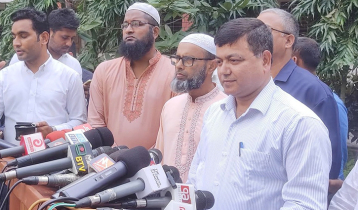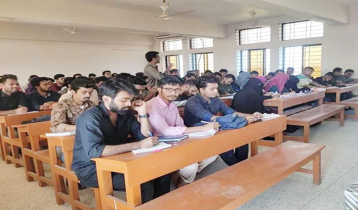Shoshi Lodge: Mymensingh’s historical palace
Khatun-A-Jannat Asha || risingbd.com

Located in the heart of Mymensingh city, the 200-year-old Shoshi Lodge is proud of the identity of a royal family. Knowing the history, it would seem that someone had a grudge against this dynasty. However, the magnificent construction style of this picturesque palace built on 9 acres of land is not the imperfection of this royal family, it is symptomatic of their nobility.
The first builder of this palace was Suryakanta Acharya Chowdhury, the zamindar (landlord) of Muktagacha. The history of his heredity shows that the founder of the then Muktagacha landlord was Sri Krishna Acharya Chowdhury, whose third successor was Raghunandan Acharya Chowdhury. He was childless.
So he adopted Gaurikanta Acharya Chowdhury. Before his death, Raghunandan handed over all his belongings to his adopted son. However, Gaurikanta Acharya Chowdhury also had no children. Although Gaurikanta died without leaving an heir, his widow Bimala Devi did not give up. He adopted Kashikant.
But alas! Kashikanta also passed away in the same way as childless suffering from a long illness. His widow Lakshmi Devi Acharya Chowdhurani followed the footsteps of her ancestors and adopted Chandrakant. Chandrakanta also left the world very quickly. However, Lakshmi Devi did not give up. She adopted another son named Purnachandra Majumdar.
In the grand procession, Lakshmi Debi gave a new name to her son- Suryakanta Acharya Chowdhury. In the joke of the Goddess of fate, he too was childless and adopted a son named Shashikanta Acharya Chowdhury to protect the heritage and pride of his kingdom.
Suryakanta Acharya Chowdhury was not only a king but also a Maharaja in the true sense of the word. And he had a small state in Alappshing pargana and today, people call it Muktagacha. His ancestors were the favorite persons of the Nawabs of Murshidabad.
At the willpower of the Nawabs, their kingdom was doing very well, but the sun of Bengal was setting in the Palashi and it was getting dark in the Alappsingh Parganas as well. The sun then rose again in Alappsingh when the British East India Company declared a permanent settlement of Bengal.
Maharaja Suryakanta was a cultured man. He was the patron of the theater. He was also active in the movement to prevent the partition of Bengal. He did a lot of public welfare work in the vast context of his 41 years of supervision of this zamindari.
Suryakanta Acharya Chowdhury during his reign established some artistic structures in Mymensingh city, as part of which he built a stunning two-storied house on 9 acres of land in the center of Mymensingh city at the end of the nineteenth century, named after his adopted son “Shoshi Lodge”.
Maharaja Suryakanta wanted to make the lodge very luxurious. At that time, it’s more than two hundred years ago a musical stair box was brought from Paris for three lakh taka, which was installed in this lodge.

Suryakanta Acharya Chowdhury was deeply saddened when this magnificent building with red bricks and yellow walls collapsed in the Great Indian Earthquake on 12 June 1896.
In 1905, his adopted son and later landlord Shashikanta Acharya Chowdhury built this lodge again on the same spot. In 1911, the young zamindar accomplished some more renovations to enhance the beauty of Shoshi Lodge and it has appeared more impeccably. He was the one who brought the marble statue of Venus from Italy and placed it in the middle of the colorful fountain in the garden of the palace.
The main entrance to the Shashi Lodge has 16 domes, a huge garden you will find in front of the main building as soon as crossing the gate, and a white stone fountain in the middle of that garden, in the middle of which stands the bathing marble statue of the Greek goddess Venus. Just behind the garden is the main palace of the Shoshi Lodge with 18 spacious rooms built of red brick and yellow walls. Next to it, there is a lotus garden.
The arena called Rongyaloy is a few steps beyond the corridor through the main palace of Shoshi Lodge. The restroom is on one side of that lovely arena. After the restroom, there is a hall room with a wooden floor. Next to the hall room is another fountain made of colorful marble stone. Crystal clear glass chandeliers hanging from the roof just above the water fountain. Inside, almost every house has chandeliers that look the same, as well as antique furniture inlaid with exquisite dexterity used by the zamindars.
In addition to the living room, it has a dance hall and a shower room. There is a secret tunnel inside the shower room. It is believed that this tunnel was used by the zamidars traveling the original palace of Muktagacha. There is also a shower room at the back of the main building. This shower room has two floors at the back of the house, next to an attractive pond.
No other zamindar house in Bangladesh has such an elite two-storied shower room. There is no way to understand that this house was used by the queens for bathing if it was not written in the monument standing in front of the entrance! Sitting here, the zamindar’s wife used to watch the ducks play in the pond next to it. The ghat of this pond made of marble stone is more picturesque which one of the favorite places are for visitors.
There is a backyard in the back of the building. As soon as crossing the yard with green grass, it is a vast reservoir. The palace is surrounded by several rare and ancient plants. Such as: Nagalingam, Jya Arjun, Jamrul-Bakul, Randhachura, Golap-Kamini etc. Nagalingam fruit is the elephant's favorite food.
During the partition of the country, the householder left Shoshi lodge and went to Calcutta. Shashikant studied at Oxford. So after the partition, he had no way to stay in Bangladesh. As a result, there was no one to take care of this palace. Inadvertently, the plaster began to fall from the wall of Shoshi Lodge. Algae and fungi began to grow on the body of the goddess Venus. This aesthetic architecture was also damaged in the war of 1971.
Shashilaj has been used as a female teacher training center since 1952. Since then its main building has been used as the principal's office. It has been renovated since it was taken over by the Department of Archeology in 2015. At present, some security personnel is in charge of the house. Apart from the people of this area, innumerable visitors from different parts of the country come here every day.
The episodes of the famous drama series “Ayomay” written by Humayun Ahmed and directed by Nawazish Ali Khan, were recorded here and aired on BTV. After airing the drama “Ayomay” this palace got more publicity as “The Palace of Mymensingh” in the whole country.
A serial drama called “Rakhal Bandhu” was also shot here. In 2016, BTV's most popular program “Ittadi” directed by Hanif Sanket was shot and later some more TV dramas and music videos were also shot on the premises of this famous building. This artistic old palace reminds us of the history of the great people who had reigned these provinces with power and nobility.
(Khatun-A-Jannat Asha is a media activist)
Mymenshing/Cynthia/Mahfuz





































